Build a Minimum Viable Product: The MVP Development Guide in 2025

In the high-stakes world of software development, one strategy stands out as a turning point: building an MVP (Minimum Viable Product).
Assume this—you launch a fully-featured, complex software application right from the start. The development costs? Astronomical. The risk? Even higher—especially if it’s something nobody wants. That’s why MVP Development is a smarter approach.
Now, try a different approach. Instead of going all in, you Build a Minimum Viable Product: a basic, functional version with a core set of features that solves a key problem for a specific group of users. This allows you to gather real-world feedback, refine the product, and ensure you’re building something that truly resonates.
That’s the power of an Minimum Feature Set Product🏆🎖️🥇
The Numbers Speak Volumes
- 87% of Agile teams prioritize MVPs in software development (Source: Agile Survey 2024).
- 9 out of 10 successful startups credit their MVP for securing early traction (Source: CB Insights).
MVPs are transforming how products are built—saving companies from costly missteps, delivering faster results, and laying the foundation for sustainable growth.
Want to avoid a product launch flop and create something your audience will love? Partnering with a product development company can help you.
Keep reading to uncover how to create a minimum viable product for your next big idea.
Table of Contents
The Benefits of building an Minimum Viable Product (MVP)
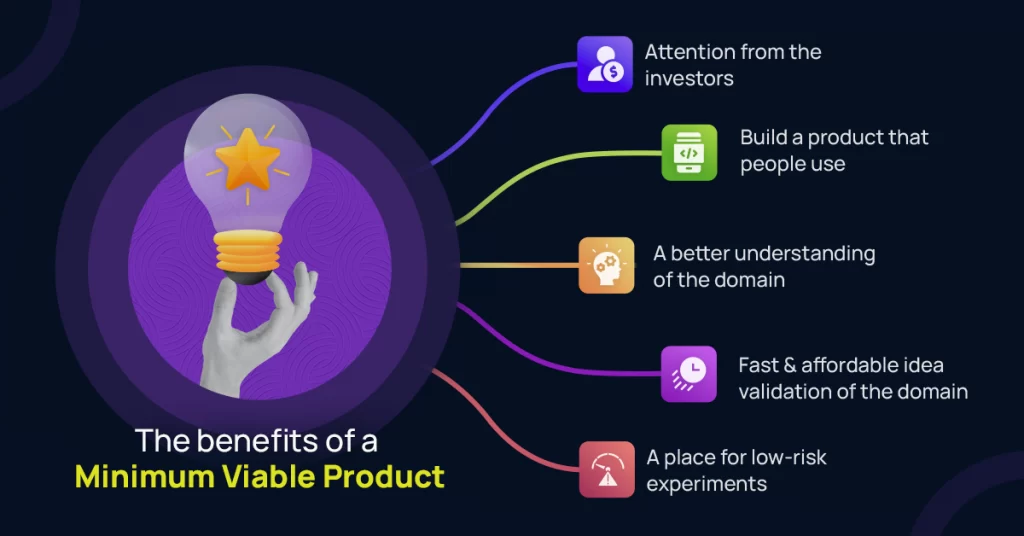
Listen up, because this is important. After working with countless startups, we’ve discovered five key benefits of MVPs that can help you throughout this journey.
Let us break it down for you.
✅ It Gets Investors Hooked
Imagine walking into a pitch meeting with actual user feedback, early success metrics, and proof that people love your idea. That’s what an MVP brings to the table. Investors don’t just want dreams—they want results.
An MVP shows them you’ve already done the groundwork, making it easier to win their confidence (and their funding).
✅ You Build Something People Actually Use
The worst feeling is spending months building a product no one wants.
A product with minimum viable features will save you from that nightmare. By launching a stripped-down version, you let your users tell you what they love (and what they don’t). This is key to MVP creation and successful MVP development.
The result? A product that’s laser-focused on solving real problems for real people.
✅ Learn the Game as You Play
Every industry has its quirks, and there’s no better way to learn them than by diving in.
Building an MVP gives you hands-on experience in your niche. You’ll uncover insights about your market, audience, and competition that no amount of research could teach you.
✅ Validation Without Burning Cash
We all know that full-scale development is expensive. Why bet big when you can validate your idea with a fraction of the cost? An MVP lets you see if your concept has legs—fast. If it doesn’t, you pivot. If it does, you double down. Either way, you save time and money.
✅ Experiment Without Fear
Think of an Product with minimum viability as your testing ground.
- Want to try out a new feature?
- Test pricing strategies?
- Experiment with design tweaks?
Go for it. MVPs give you room to play without risking everything. Every experiment makes your product better, and every failure teaches you what not to do.
MVP helps you stay lean, learn fast, and build smarter. If you’re serious about creating a product that sticks, starting with Product at minimum viability is a no-brainer.
Real-World Examples of Companies That Have Undertaken Minimum Viable Product (MVP) Development Services
Did you know this? Some of the biggest tech companies today started with basic MVP building strategies that are the foundation of minimum viable product development.
We’ve studied these success stories extensively, and they’re pure gold for entrepreneurs looking to build MVPs effectively.
🏆 Spotify: From Zero to Music Streaming Giant
Remember downloading MP3s?
In 2006, Spotify didn’t try to launch a fancy streaming platform. Instead, they built an MVP—a simple desktop app that played local music files. That’s it. No playlists, no social features, nothing fancy.
Here’s the crazy part: Spotify grew 20% month-over-month in Sweden by solving one key problem—making music instantly playable without waiting for downloads. The result? They secured $21.6M in funding.
That’s the power of creating an MVP that focuses on solving a specific need.
🏆 Zappos: A Billion-Dollar Company Built on Photos
This one blows my mind every time. Nick Swinmurn didn’t start with a complex e-commerce platform. Instead, he built an MVP by taking photos of shoes from local stores and posting them online. When someone ordered, he’d go to the store, buy the shoes, and ship them himself.
Get this: Zappos hit $1.6M in sales in its first year with this bare-bones approach. Eventually, Amazon acquired the company for $1.2B.
Develop MVP that validates a single, simple assumption—in this case, that people would buy shoes online without trying them on.
🏆 Groupon: From WordPress Blog to Daily Deals Empire
Want to hear something crazy?
Groupon started as a WordPress blog. Not a sophisticated deals platform or a complex marketplace—just a simple blog where they email PDF coupons. They even used AppleScript to handle emails manually.
The results? Groupon sold 400 pizza vouchers in its first week. Within six months, they hit $1M in revenue. Why? Because they proved people wanted local deals before investing in building a full-fledged platform.
Their Secret to MVP Success
These companies didn’t succeed because they built perfect products—they succeeded because they tested their core assumptions fast and affordable. Many startups fail because they try to build everything at once.
What did you learn from this?
Start small, test quickly, and let your users guide your growth. When you build an MVP that solves one problem really well, you’re setting the foundation for long-term success.
These examples prove that perfection isn’t the goal—progress is.
How to Build a Minimum Viable Product (MVP) from Scratch: A Development Guide
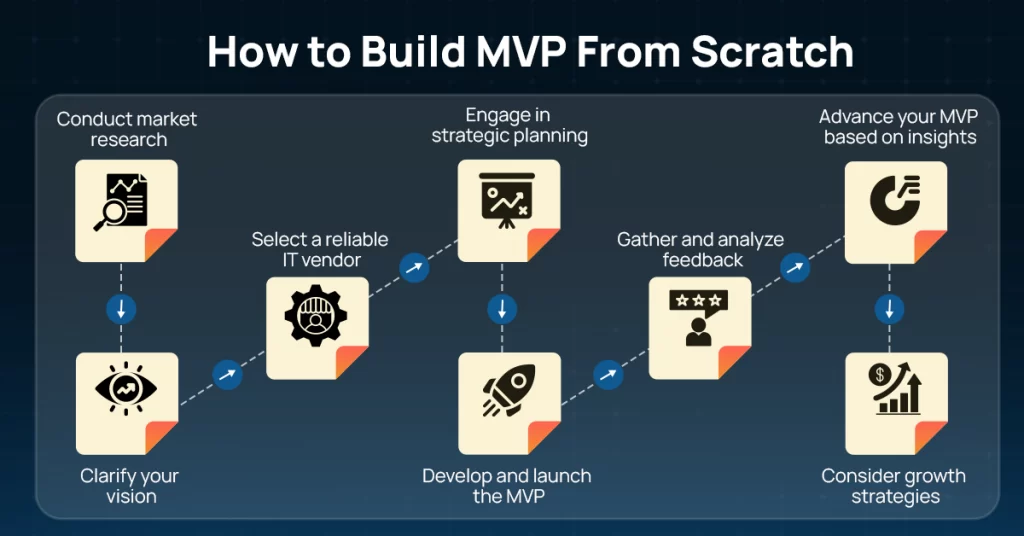
Building an MVP isn’t just about creating a “stripped-down” version of your product. It’s about making smart decisions at every step to validate your idea and prepare for long-term success in MVP development.
Here’s how to build a minimum viable product step by step:
➡️ Understanding Your Market: It Starts with the Problem
Before you even think about writing a single line of code, you need to know if your idea solves a real problem. Skipping this crucial step is like navigating without a map—you might get somewhere, but it’s unlikely to be where you intended.
How to Start: Get out there and talk to your potential users. Surveys and focus groups are great, but even casual conversations can reveal invaluable insights.
Tools You Can Use: Online survey platforms like Typeform and Google Forms are helpful, and don’t underestimate the power of social media polls for quick feedback.
Don’t forget to check out what your competitors are doing. What are their users saying? What are the pain points? Find out the answer to these questions and move to the next step.
➡️ Defining Your Core Purpose: What’s the One Thing?
Your MVP shouldn’t try to be everything to everyone. It needs to focus on solving one core problem exceptionally well. Trying to cram in too many features early on is a classic recipe for disaster.
Start With This Question — When you build an MVP, ask yourself: What’s the one essential thing your product must achieve?
The “Job-to-be-Done” framework can be incredibly helpful here. It forces you to define what Minimum version of your viable product absolutely must accomplish for the user.
Think of Uber’s early days. Their MVP wasn’t about revolutionizing transportation; it was simply about connecting people who needed a ride with drivers who could provide one, using a mobile app.
➡️ Choosing the Right Team: Your MVP’s Foundation
Your development team is crucial to your MVP development process and the success of your custom MVP product. A skilled and experienced vendor who understands the lean principles of MVP development can make all the difference.
What to Look For: Look for a vendor with a proven track record in Agile development, excellent communication skills, and a portfolio showcasing successful Minimum Feature Set Product projects.
Questions to Ask:
- Have you built MVPs before?
- Can you handle scaling if our product takes off?
Popular Platforms to Find Vendors: Platforms like Upwork, Clutch.co, and companies like CONTUS Tech can be a good starting point.
➡️ Strategic Planning: Keeping Scope in Check
In MVP development for startups, one of the biggest challenges is avoiding scope creep—the gradual expansion of features beyond the original plan. A solid strategy is crucial to stay focused and deliver value within time and budget constraints.
The Moscow Method is a great way to prioritize features:
- Must-Have: These are the absolute essentials—without them, your MVP doesn’t solve the core problem.
- Should-Have: These are nice-to-haves that can enhance the user experience, but they’re not critical for the initial launch.
- Could-Have: These are features you could add if you have extra time and budget, but they’re definitely not a priority for the Minimally viable product.
- Won’t-Have: These are features to park for future versions.
➡️ Development and Launch: Done is Better Than Perfect
Perfectionism can be a real enemy when developing an MVP. The goal is to get a functional product into the hands of users as quickly as possible, not to create a flawless masterpiece.
- Design a simple and intuitive user interface (UI) to minimize the learning curve for users.
- Focus on core functionality—resist the temptation to add extra bells and whistles in the first version.
- Thoroughly test your MVP for bugs using tools like TestRail or Bugzilla.
Airbnb’s product, at its minimum stage, was incredibly simple—just a basic website with a few listings. But it was a viable idea that proved people were willing to pay to stay in someone else’s home, making it a strong product.
➡️ Gathering and Analyzing Feedback: Listen to Your Users
The real learning begins after you launch your MVP. User feedback is gold—it tells you what’s working, what’s not, and what needs to be improved.
How to Collect Feedback
- Use tools like Hotjar to see how users are interacting with your product.
- Send out targeted feedback surveys using platforms like Typeform or Google Forms.
- Engage directly with users on forums, social media, or even through direct email.
What to Look For
- Are users able to complete the core actions you designed the MVP for?
- What features are missing or feel unnecessary?
➡️ Iterating Based on Insights: Turning Feedback into Action
Once you’ve gathered feedback, it’s time to iterate. Use the data to refine your product and focus on what matters most to your users.
Steps to Take
- Address any usability issues that users have reported.
- Prioritize adding features that address the most common user requests.
- Remove any elements that are confusing, distracting, or detract from the user experience.
➡️ Planning for Growth: Scaling Your Success
Your Minimum version of a viable product is just the starting point. As you gain traction, you need to start thinking about how to scale your product to handle growth.
How to Scale
- Strengthen your backend infrastructure to handle increased traffic and data.
- Double down on the marketing strategies that proved effective during the MVP phase, such as social proof and influencer marketing.
- Explore potential partnerships or collaborations to reach new markets and expand your user base.
Did You Know ?
Ready to get started?
The best Minimum Feature Set Product’s are built on a foundation of smart strategy, a deep understanding of user needs, and a commitment to continuous iteration. Take the first step today and let your MVP guide you on the path to success.
5 Development Mistakes to Avoid at All Costs for a Successful MVP Launch
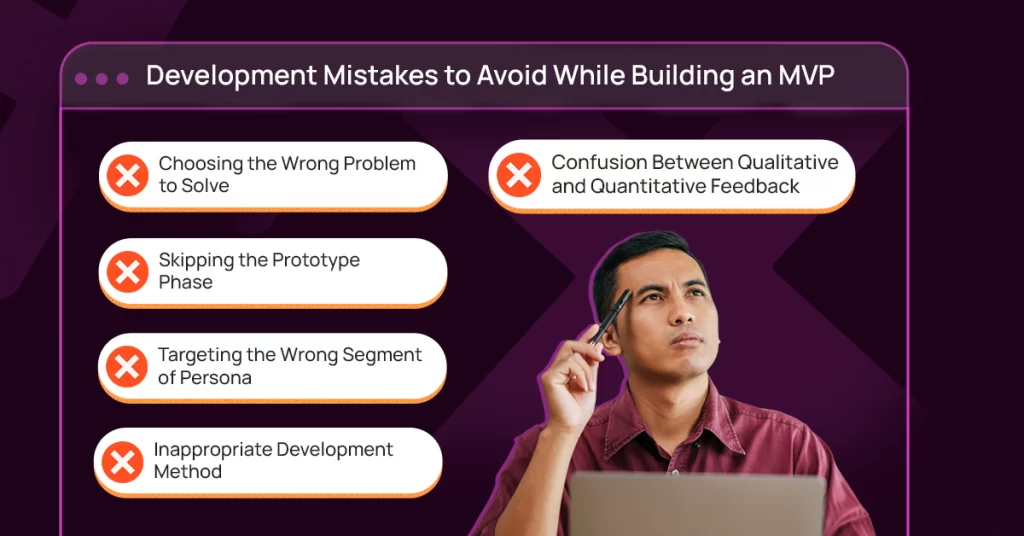
You’re pouring your energy into building an MVP, meticulously planning every feature.
But are you overlooking the hidden traps that can derail your entire project? They’re subtle mistakes that often go unnoticed until it’s too late.
We’ve uncovered five of these silent killers that are wreaking havoc on startups. Avoid them, and you’ll put the minimum effort into building a viable idea that transforms into a strong product, setting it on the fast track to success.
⚠️ Solving a Problem Nobody Cares About (The Ultimate MVP Killer)
This is the biggest mistake of all. You’re building a solution in search of a problem. You think people need it, but you haven’t validated it. This is where market research is crucial. Use keyword research tools to see if people are searching for solutions to the problem you’re trying to solve. Look at social media trends. Are people talking about this problem? If not, you’re wasting your time. Data doesn’t lie.
⚠️ Skipping the Prototype Phase
A prototype is your MVP’s blueprint. It’s a low-fidelity version that helps you test the user experience and gather feedback before you invest in full development.
Skipping this phase is like building a house without blueprints – you’re setting yourself up for disaster. Prototypes can be simple wireframes, mockups, or even clickable prototypes created with tools like Figma or InVision.
⚠️ Targeting the Wrong Customer Segment
You can have the best Product with minimum viability in the world, but if you’re targeting the wrong audience, it’s going to fail. You need to have a crystal-clear understanding of your ideal customer.
Create detailed buyer personas. What are their demographics, psychographics, needs, and pain points?
Use data from Google Analytics, Facebook Audience Insights, and customer surveys to refine your targeting.
⚠️ Using the Wrong Development Methodology
There are different development methodologies, such as Agile, Waterfall, and Lean. Choosing the wrong one can lead to delays, cost overruns, and a subpar product.
For MVPs, Agile and Lean methodologies are generally the best choice because they emphasize iterative development, flexibility, and customer feedback.
NOTE: Agile is often the best fit for MVPs.
⚠️ Confusing Qualitative and Quantitative Feedback
Qualitative feedback (like user interviews and surveys) gives you insights into why users behave in a certain way. Quantitative feedback (like analytics data and A/B testing results) tells you what is happening. You need both. Don’t rely solely on one or the other.
Analyze your data to understand both the “why” and the “what.”
By avoiding these five common mistakes, you’ll significantly increase your chances of building a successful product at minimum viability and launching a thriving business.
Now go out there and build something amazing!
Stop Wasting Money: 10 Questions to Ask Before Building Your Minimum Viable Product Development Plan
Building a Minimum Viable Product (MVP)?
Awesome!
It’s the lean startup way to validate your idea without burning through your entire budget.
But here’s the brutal truth: most MVPs fail. Why? Because they skip the crucial groundwork. They build something nobody wants. Ouch.
Before you write a single line of code (or spend a dime on development), you need to answer these 10 critical questions.
1️⃣ What Pain Point Are You Really Solving? (Your Killer Value Proposition)
2️⃣ Who Are Your Ideal Customers? (Laser-Focused Targeting)
3️⃣ Is There Real Market Demand? (Market Size and Potential)
4️⃣ How Will You Measure Success? (Data-Driven Metrics and Monetization)
5️⃣ Who Are Your Competitors (And What Are They Doing Wrong)?
6️⃣ What’s Your Unique Selling Proposition (USP)? (Standing Out From the Crowd)
7️⃣ Why Now? (Market Timing and Trends)
8️⃣ What’s Your Go-to-Market Strategy? (Driving Traffic and Conversions)
9️⃣ What Are the Must-Have Features? (Focusing on the Core Value)
🔟 Based on the Data, Should You Actually Build This? (The Final Verdict)
Final Thoughts
As we conclude our deep dive into the world of Minimum Viable Products, one thing is clear: adopting the Minimum Feature Set Product mindset is no longer optional—it’s essential for success.
When you build a minimum viable product, you distill your vision into its most critical features, reducing risks, accelerating time-to-market, and creating a loyal user base eager to shape your product’s evolution.
Key Takeaways for MVP Success
- Validate, Don’t Assume: Let real user feedback guide your product’s journey.
- Iterate with Purpose: Use data to make meaningful improvements.
- Perfection is Overrated: Launch, learn, and refine—continuously.
Ready to Build a Minimum Viable Product?
With over 16 years of experience in MVP development and in product development consulting services, CONTUS Tech helps startups and enterprises build MVP solutions that lead to long-term growth.
Recognized among leading product development companies, Their agile development methodology ensures rapid iteration and fast deployment, enabling you to gather valuable user feedback and refine your product quickly.
The next big success story could be yours. Take the first step today.
Ready to Build an MVP?


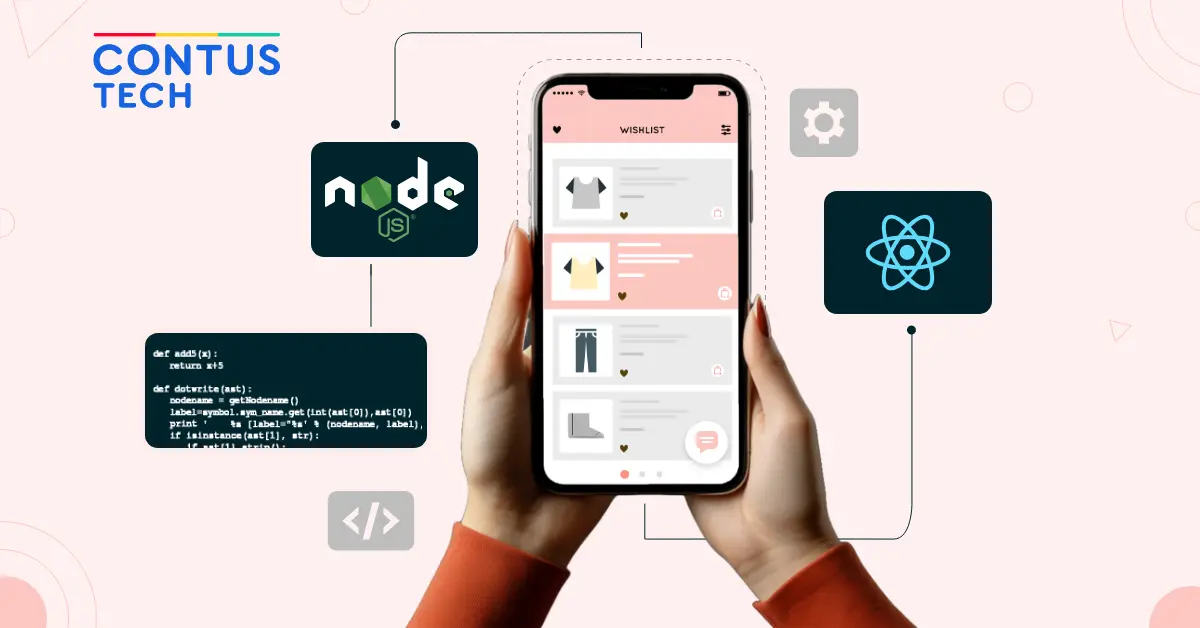
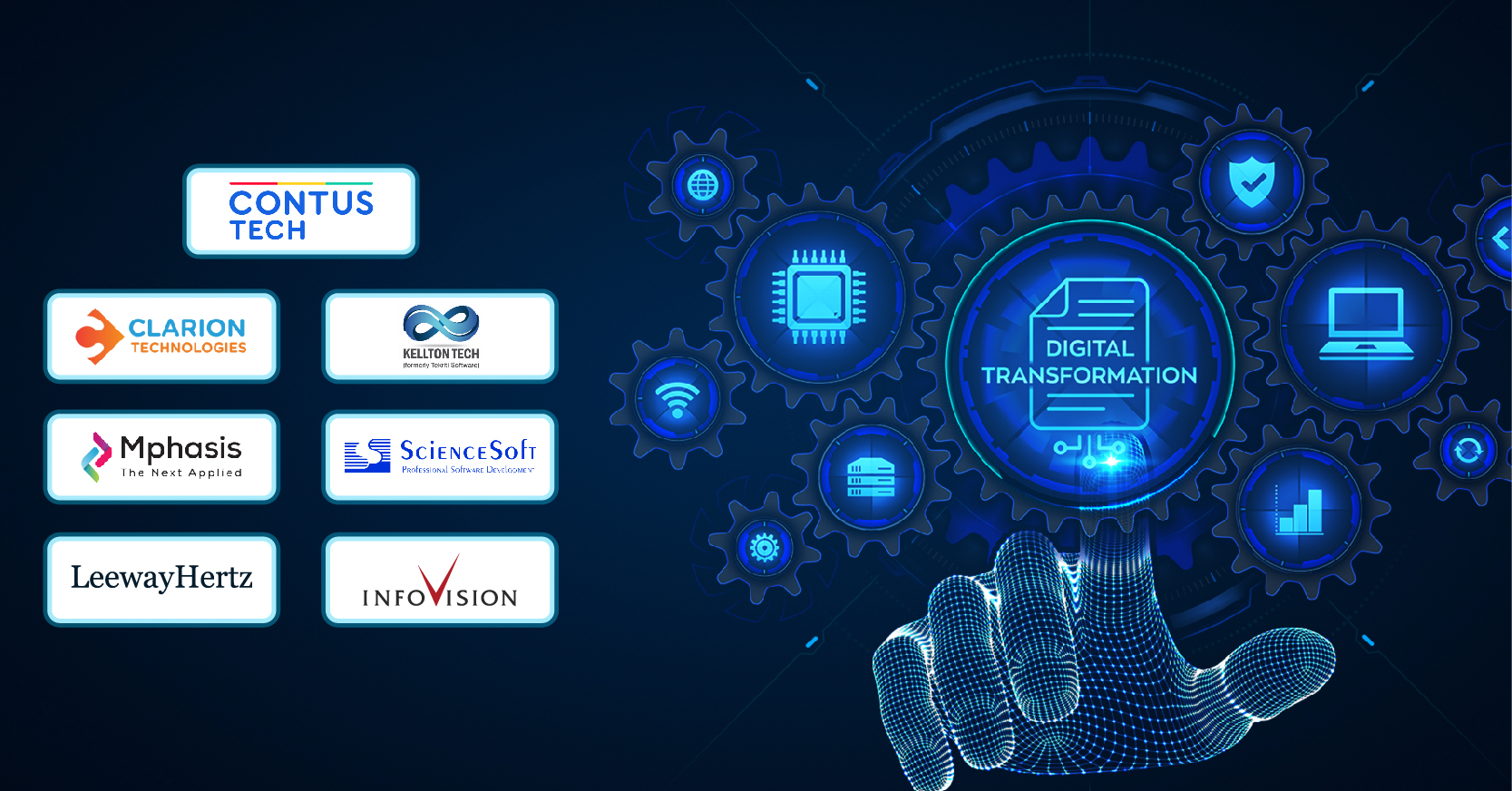
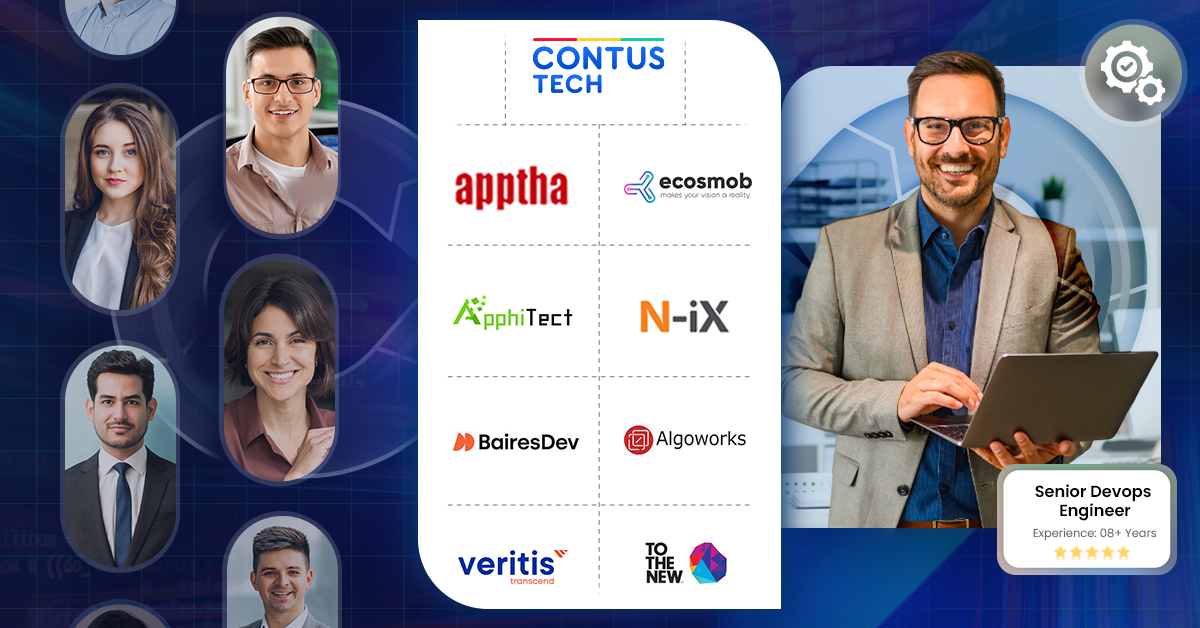
How do I start to build an Minimum version of a viable product without over complicating it?
To build an Minimum version of a viable product effectively focus on understanding the core user problem. Start small by identifying pain points and validate your idea with simple tools or surveys. This way you can build or can create a minimum viable product that solves real problems for startups.
What are the best tools to create an Minimum Feature Set without coding?
To create a minimum viable product without coding, use platforms like Bubble, Glide or Webflow. These tools allow you to develop an Minimum Feature Set quickly and cost effectively making them perfect for building an Minimally viable product for startups on a budget.
How do I prioritize features when developing A product that is minimally viable?
When building a minimum viable product use frameworks like MoSCoW to decide which features are “Must-Have.” Focus on solving the core problem as this ensures your Minimally viable product resonates with users while keeping the development lean.
What’s the process to develop an Product with minimum viability on a tight startup budget?
To develop an Product with minimum viability on a limited budget leverage no code platforms and test prototypes. Create an Minimally viable product without coding to validate ideas quickly. This approach helps startups build a minimum viable product without incurring high development costs.
How can I gather user feedback while building A product with minimum viable features?
To gather feedback while building a minimum viable product use tools like Hotjar or Google Forms. Engaging with users directly helps you iterate your Minimum version of a viable product. For startups this feedback loop ensures you are creating an Minimum Feature Set that aligns with market needs.
How can I avoid building an Product at minimum viability that fails to attract users?
To avoid failure focus on solving one core problem effectively. Building an Product at minimum viability for startups requires validating the market need before adding features. Use lean principles & Agile methods to develop an Product at minimum viability that users actually need.
What steps should I follow to build an Minimum Feature Set product that attracts investors?
When you create a minimum viable product include real world user feedback and success metrics. Investors are drawn to MVPs that demonstrate validated demand. Building an Minimum Feature Set Product for startups with clear results increases your chances of securing funding.
How do I scale after creating an Minimum Feature Set Product that gains traction?
To scale your Minimum Feature Set Product strengthen backend systems and expand your feature set based on feedback. Building an Product at its minimum viable state for startups means planning for growth from day one while iterating the product to meet user demands.
What are some real world examples of successful Minimally viable product?
Companies like Spotify and Zappos started by building simple Minimum Feature Set Product’s. Spotify created a minimum viable product focused on local music playback. These examples highlight how startups can build an MVP that solves one problem effectively.
How do I create an Minimum version of a viable product that evolves with user needs?
To create a minimum viable product that evolves focus on iterative development. Continuously gather feedback, analyze user behavior and update features. Developing an Minimum version of a viable product this way ensures startups adapt to market changes and user expectations.
How can I start to build A product with minimum viable features without coding experience?
To build A product with minimum viable features without code use tools like Bubble, Glide or Webflow. These platforms allow you to create a minimum viable product quickly focusing on your idea’s core functionality without needing to write any code.
What’s the best way to identify key features when building an Minimum Feature Set Product?
To build a minimum viable product focus on solving one specific problem. Use the MoSCoW method to prioritize features and ensure that your Minimum Feature Set Product delivers maximum value without overcomplicating development.
How can I validate my idea before I build A product that is minimally viable?
To validate your idea for building a minimum viable product, conduct surveys, create landing pages & use tools like Google Forms. Engage potential users to ensure your Product at minimum viability solves a real problem saving you time and resources.
Are there examples of startups that succeeded by building an MVP?
Absolutely! Spotify built an MVP focusing on playing local music files while Zappos created a minimum viable product using photos of store bought shoes. Building an MVP helped them validate demand and grow.
What tools can I use to build a minimum viable product without coding?
Use no code platforms like Bubble for web apps or Adalo for mobile apps to create an MVP without coding. These tools are perfect for startups looking to build an MVP quickly & affordably.
How can I avoid common mistakes while developing an Minimum Feature Set for my startup?
When you develop an Minimally viable product focus on solving a real problem, don’t skip prototyping & prioritize features. Use Lean or Agile methods to avoid scope creep ensuring your minimum viable product stays efficient & effective.
How can building a minimum viable product help me attract investors?
Investors love startups that create a minimum viable product with real user feedback. Building an Product at minimum viability shows traction, validates your idea and proves there’s demand making it easier to secure funding.
How do I gather user feedback after creating an Minimum version of a viable product?
Once you build an Minimum version of a viable product use tools like Hotjar and Typeform to gather user feedback. Social media & direct conversations are great ways to understand how users interact with your minimum viable product and what improvements they need.
Should I develop an Minimally viable product from scratch or use no-code tools?
If your startup idea is unique build a minimum viable product from scratch. If not use no-code platforms like Webflow to save time and money. Building an Minimally viable product this way allows faster testing and iteration.
How can I scale my startup after successfully building an Minimum Feature Set?
After creating a minimum viable product focus on scaling by improving infrastructure, adding features users request and optimizing for growth. Developing an MVP first allows startups to iterate effectively and expand smartly.
How do I ensure I’m solving the right problem when I build A product that is minimally viable?
Focus on user validation. Talk to potential customers, conduct surveys & analyze their pain points. Start with a single problem your Product at its minimum viable state solves effectively and refine it based on feedback.
What’s the most cost effective way to create an Minimum version of a viable product without coding?
Use no-code tools like Bubble, Glide or Zapier to build Minimum version of a viable product prototypes. These platforms allow you to test functionality and gather feedback without the expense of custom development.
How do I prioritize features when developing A product with minimum viable features for startups?
Use the MoSCoW method: categorize features as Must Have, Should Have, Could Have, and Won’t Have. Focus only on Must-Have features that solve your core problem.
What type of team should I hire for minimum feature set development services?
Look for a team experienced in Agile methodologies with expertise in minimum feature set development. They should understand how to iterate quickly and focus on user feedback to refine the product.
Can you explain how to build an Minimum version of a viable product that attracts investors?
Showcase real traction. Build a minimum viable product with data-driven results—early adoption rates, user feedback, and proof that it solves a key problem. This builds investor confidence.
How do I gather user feedback effectively after launching an Product at its minimum viable state?
Use tools like Hotjar for behavioral analytics, Typeform for surveys, and social media platforms to directly engage users. Their feedback will guide iterations.
What is the best development methodology to create an Minimally viable product?
Agile development is ideal. It emphasizes quick iterations, user involvement, and continuous improvement, making it perfect for Minimally viable product development for startups.
How do I avoid overbuilding when creating an Minimally viable product?
Stay disciplined. Define a clear problem and develop only the essential features. Regularly revisit your goals to ensure alignment with the core purpose.
Is it possible to build an Product with minimum viability without coding skills?
Absolutely! Platforms like Airtable, Webflow, or Adalo allow you to create Product with minimum viability without coding. They’re great for testing ideas and iterating quickly.
How do I plan for scaling after my Product at minimum viability is successful?
Build scalable architecture from the start and monitor user metrics. Focus on strengthening infrastructure, optimizing UX, and planning feature rollouts aligned with user demand.